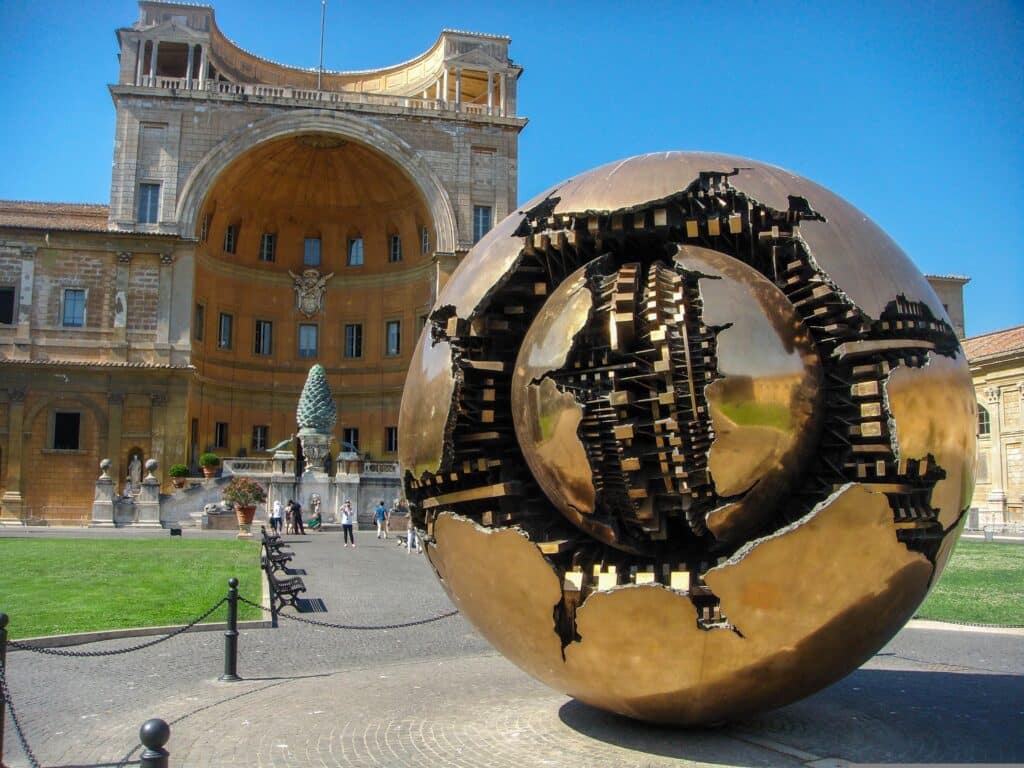
The entrance fee for the Vatican Museums is 25.00€ for 2025. If you want to buy your ticket not online but at the Vatican Museums ticket office, this entrance fee drops to 20€. Children under 6 years of age are admitted to the Vatican Museums free of charge, while children between 6-18 years of age have a discounted entrance fee to the Vatican Museums. Also, entrance to the Vatican Museums is free on the last Sunday of every month (but it can be very crowded).
Since it is possible to wait for hours in the queues at the ticket office for the museums, where an average of 25,000 people enter the museums on a daily basis, we recommend that you buy your entrance ticket online. We also recommend that you visit the Vatican Museums as part of a guided tour due to the important artefacts it contains. Learning the history of the artefacts you visit will make your visit to the Vatican meaningful.
The Vatican Museums, which occupy much of the Vatican Palace in Viale Vaticano, contain one of the world’s greatest art collections. The history of the museums goes back to 1506, when Pope Julius II, pursuing the ideals of the Renaissance, began to collect ancient works of art. The collections were increased over the centuries by art treasures from the territories of the Papal States, works of art presented to the Popes and items related to the work of the Roman Catholic Church.
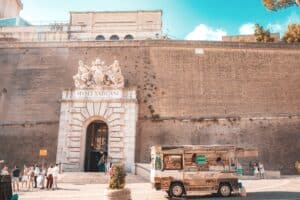
Entrance of the Vatican Museums
In addition there are works of art created specifically for the Vatican Palace, including the paintings in the Sistine Chapel and the Stanze di Raffaello. The museums are closed on Sundays and public holidays.
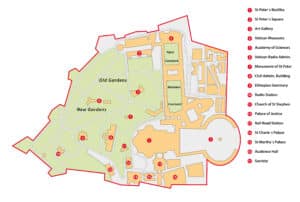
Vatican City Map – Image Credit: Vatican City Guide with Map
Pinacoteca (Picture Gallery)
The Pinacoteca, founded by Pius VI and later robbed of many of its treasures by Napoleon, contains in its 16 rooms a collection of pictures, ranging in date from the Middle Ages to the present day, which gives an excellent survey of the development of Western painting. The pictures are arranged in chronological order.
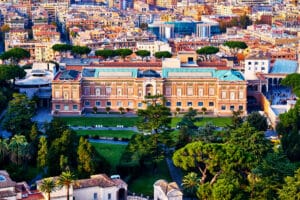
Pinacoteca Vaticana, part of the Vatican museums
Pictures of particular note include the following:
Room I: Medieval art (Byzantine, Sienese, Umbrian and Tuscan), including a liturgical vestment (pluviale) which belonged to Pope Boniface VIII (13th c).
Room II: Triptych of Cardinal Stefaneschi (Giotto).
Room III: “Madonna” and “St Nicholas of Bari” by Fra Angelico, triptych by Filippo Lippi.
Room V: “Pieta” by Lucas Cranach the Elder.
Room VII: “Coronation of the Virgin” by Pinturicchio, “Madonna” by Perugino.
Room VIII: Tapestries from cartoons by Raphael, and Raphael’s famous “Transfiguration” (1517: his last picture) and “Madonna of Foligno” (1512-1 3).
Room IX: “St Jerome”, an unfinished work by Leonardo da Vinci.
Room X: “Madonna” by Titian.
Room XII: “Entombment” by Caravaggio.
Room XIV: Dutch and Flemish masters (school of Rubens).
Room XV: Portraits of Popes.
Museo Gregoriano Egizio (Egyptian Museum)
The Egyptian Museum in the Cortile della Pigna, re-founded by Pope Gregory XVI (the first collection having been assembled by Pius VII), contains a small but valuable collection of Egyptian art from the 3rd millennium B.C. to the 6th c. B.C., including basalt and wooden sarcophagi, heads of gods and pharaohs, mummified heads, stelae, statues of gods and animals and papyri.
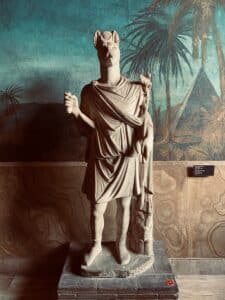
Vatican Museums – Egyptian Museum
Vatican Museums : Pio-Clementino Museum
The Vatican Museums have the largest collection of ancient sculpture in the world, mailnly found in Rome and the surrounding area. The collection was arranged on a systematic basis by Popes Clement XIV (1769-74) and Pius VI (1 775-99). Among outstanding items are the following: Sala a Croce Greca: the porphyry sarcophagi of Constantia (Constantine’s daughter) and St Helen (his mother), richly decorated with figures and symbols.
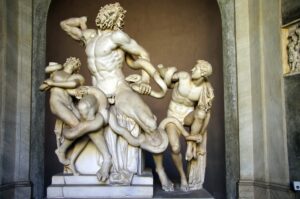
Laocoon and His Sons – Cortile del Belvedere – Vatican Museums
- Sala Rotonda: Zeus of Otricoli, a copy of a work by Bryaxis (4th c. B.C.).
- Sala delle Muse: Belvedere Torso, a work by Apollonius of Athens (1st c. B.C.) which was admired by Michelangelo; statues of Apollo and the Muses.
- Sala degli Animali: numerous realistic marble and alabaster statues of animals; statue of Meleager with dog and a wild boar’s head (Roman copy).
- Galleria delle Statue: Apollo Sauroctonus (Apollo the Lizard- Killer: Roman copy of a bronze original by Praxiteles); the Candelabri Barberini (the finest ancient candelabras known), from the Villa Adriana at Tivoli.
- Cabinet of Masks: Cnidian Venus, a Roman copy of the Aphrodite of Praxiteles (4th c. B.C.).
- Cortile del Belvedere: the most famous statues in the Vatican – the Apollo Belvedere (Roman copy of an original by Leochares), Canova’s Perseus, a Hermes of the Hadrianic period (copy of an original by Praxiteles) and above all the celebrated Laocoon group, a masterpiece of Hellenistic sculpture (at the finding of which in 1 506 Michelangelo was present) depicting the Trojan priest Laocoon and his sons in a mortal struggle with two huge snakes.
- Gabinetto del Apoxyomenos: the Athlete Apoxyomenos, a copy of a famous bronze statue by Lysippus, found in Trastevere in 1849.
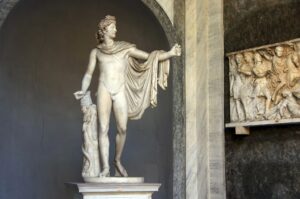
Apollo Belvedere – Vatican Museums Entrance Fee
Vatican Museums: Chiaramonti Museum
The Museo Chiaramonti, founded by Pope Pius VI (1800-23), a member of the Chiaramonti family, is housed in a long gallery leading to the Papal palace and contains numerous works of Greek and Roman art, of varying quality. There are also works of Greek and Roman sculpture in the Galleria Lapidaria and the Braccio Nuovo, which links the two long wings extending from the entrance to the museums to the Palazzi Vaticani.
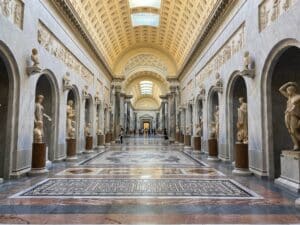
Notable items in the Braccio Nuovo are the Augustus of Prima Porta, a statue of the Emperor found in 1863 in the country villa of his wife Livia; a statue of the god of the Nile; and the Doryphorus (“Spear-Carrier”), a copy of a work by Polycletus. In the Sala della Biga, near the entrance, are two Discus- Throwers, copies of works by Myron and Polycletus (5th c. B.C.).
Etruscan Museum
The Etruscan Museum of Vatican Museums, founded by Pope Gregory XVI (1831-46), contains in its 18 rooms works of art and everyday objects which throw light on the life of the Etruscans and their ideas of the afterlife. The collection also includes Greek and Roman works.
Particularly notable items are the rich grave goods from the Regolini-Galassi tomb at Cerveteri, the Mars of Todi, the Stele del Palestrita (from Attica, 5th c. B.C.), a head of Athena and numerous fine vases.
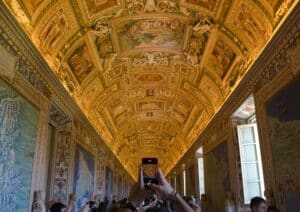
Gallery of Maps – Musei Vaticani
Museo Gregoriano Profano
This museum of secular art of Vatican Museums was also founded by Gregory XVI. Until 1 963 it was housed, along with the Museo Pio Cristiano and the Museo Epigrafico Cristiano, in the Lateran Palace (see Palazzo Laterano). It now occupies a modern museum building adjoining the Pinacoteca which was built during the reigns of Popes John XXIII (1 958-63) and Paul VI (1 963-78). The works of ancient sculpture in this excellently arranged museum were mostly found in the territories of the Papal States. It includes Roman copies of Greek sculpture and originals of Roman Imperial sculpture – statues, reliefs, funerary monuments and sarcophagi, together with works of political and religious content.
- First section: Roman copies and re-workings of Greek originals.
- 2nd section: Roman sculpture (1st and early 2nd c. ad).
- 3rd section: Sarcophagi.
- 4th section: Roman sculpture (2nd and 3rd c. ad.)
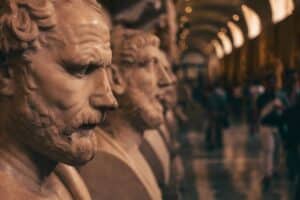
Vatican Library
Judged by the value of its contents, the Vatican Library is the richest in the world. Since its foundation by Nicholas V in 1450 the library has been systematically built up, and now contains, in addition to books printed since the end of the 15th c, some 7000 incunabula, 25,000 medieval hand-written books and 80,000 manuscripts. In the library hall, 70 m (230 ft) long, built by Domenico Fontana, are cases displaying some of its greatest treasures – Biblical codices, illuminated Gospel books, finely printed books, valuable parchments and ancient papyri and scrolls.
Borgia Apartments
The Borgia Pope Alexander VI (1492-1503) had a private residence built for himself and his family within the Vatican Palace, and commissioned Pinturicchio to decorate it with wall and ceiling paintings. Between 1492 and 1495 the painter and his assistants and pupils painted a series of scenes, combining Renaissance, humanist and ancient themes with Christian subjects:
- 1st room: Prophets and Sibyls.
- 2nd room: The Creed, with prophets and Apostles.
- 3rd room: Allegories of the seven liberal arts.
- 4th room: Legends of saints.
- 5th room: Scenes from the life of Christ and the Virgin.
- The Papal portraits formerly in the 6th room have not survivied.
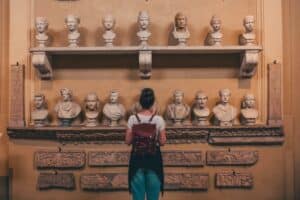
Raphael Rooms
These rooms of Vatican Museums above the Appartamento Borgia, built by Pope Nicholas V, contain a magnificent series of frescoes by Raphael, who was commissioned by the art-loving Pope Julius II in 1 508 to repaint the rooms.
Room 1 (Room of the Burning of the Borgo): Ceiling painting by Perugino, and four paintings of historical scenes by pupils of Raphael (1517 onwards): Leo IV and the burning of the Borgo (the district around St Peter’s) in 847; coronation of Charlemagne by Leo III in 800; Leo IV’s naval victory over the Saracens off Ostia in 849; and Leo Ill’s oath (denying false accusations) in 800. These paintings, commemorating his predecessors of the same name, were commissioned by Pope Leo X (1513-21 ).
Room 2 (Sala della Segnatura, the meeting-place of an ecclesiastical tribunal): The frescoes in this room, painted by Raphael in 1508-11, represent the supreme achievement of Renaissance painting. They depict the culture of the period in all its richness and splendour.
The Disputa del Sacramento, a theological disputation on the doctrine of transubstantiation, depicts the world of religious faith. In the lower zone, around the altar, are Popes, bishops, teachers and theologians, including Pope Innocent Hi, St Bonaventure and Dante. Above them, under God the Father, are Christ with the Virgin and John the Baptist, attended by saints.
The Scuola d’Atene (School of Athens), set in the newly built St Peter’s, represents the field of the natural sciences – attainable without divine revelation – and depicts representatives of philosophy (the two central figures, Plato and Aristotle, together with Socrates), architecture (Bramante), history (Xenophon) and mathematics (Archimedes, Pythagoras, Euclid), together with Raphael himself (in the corner, second from right).
Above one window is an associated scene depicting Parnassus, with Apollo playing a violin, the blind Homer, the Muses and other ancient poets (Virgil, Sappho, Ovid, Catullus and Horace). Above the other are a scene depicting the glorification of canon and civil law and allegorical representations of the virtues of Prudence and Temperance. On the ceiling, corresponding to the scenes on the walls below, are allegories of theology, philosophy, poetry and justice.
Room 3 (Sala d’Eliodoro, Room of Heliodorus): The paintings by Raphael in this room (1512-14) show still greater expressive power and a livelier sense of movement than those in the Sala della Segnatura. They depict four scenes: Leo the Great repulsing Attila, the Mass of Bolsena (in which an unbelieving priest was convinced of the truth of the doctrine of transubstantiation), the expulsion of Heliodorus from the Temple and the liberation of St Peter from prison.
Room 4 (Sala di Costantino, Room of Constantine): The painting dates almost entirely from the reign of Clement VII, after Raphael’s death. On the long wall is a fine picture (by pupils of Raphael) of Constantine’s victory over Maxentius at the Milvian Bridge.
Nicholas V’s Chapel, near the Stanze di Raffaello, has frescoes by Fra Beato Angelico on the life and martyrdom of SS. Stephen and Lawrence (1447-9).
Gallery of Candelabras and Tapestries
The Map Gallery of Vatican Museums, 120 m (395 ft) long, has maps of all the different parts of Italy, often with views of cities and prospects of scenery. Beyond this gallery (when coming from the Vatican Palace) is the Gallery of Candelabras and Tapestries, with valuable tapestries of the 15th-17thc. and Roman marble candelabras.
Other Museums
- Museo Profano: This collection of secular art includes a variety of Etruscan, Roman and medieval material.
- Museo Pio Cristiano: This museum, founded by Pope Pius IX in 1854, contains material which until 1963 was housed in the Lateran Palace. There are two sections, one devoted to architecture, sculpture and mosaics, the other to inscriptions.
- Museo Missionario Etnologico: Objects brought back from the various mission fields of the Church were originally (from 1926 onwards) displayed in the Palazzo Laterano. Pope Pius XI directed that they should be brought together in a systematic arrangement, and in 1970 all material of interest (to scholars as well as to the general public) was transferred to the Museo Missionario Etnologico.
- Museo Storico: This Historical Museum, housed in a large building under the Giardino Quadrato (Square Garden), near the Pinacoteca, displays material on the history of the Papal States, Papal carriages and weapons and uniforms of the Papal guards.
- Collezione d’Arte Religiosa Moderna: Pope Paul VI (1963-78) was interested in modern religious art, and made available 55 rooms in the Vatican for the display of works of art presented to the Popes or acquired by them. The collection contains more than 800 works by artists of many different countries, including Rodin, Barlach, Matisse, Modigliani, Kokoschka, Dali, Munch, Vlaminck, Feininger, Ernst, Beckmann, Nolde, Le Corbusier, Kandinsky, de Chirico, Greco, Marini, Rouault, Hartung and Hansing.

